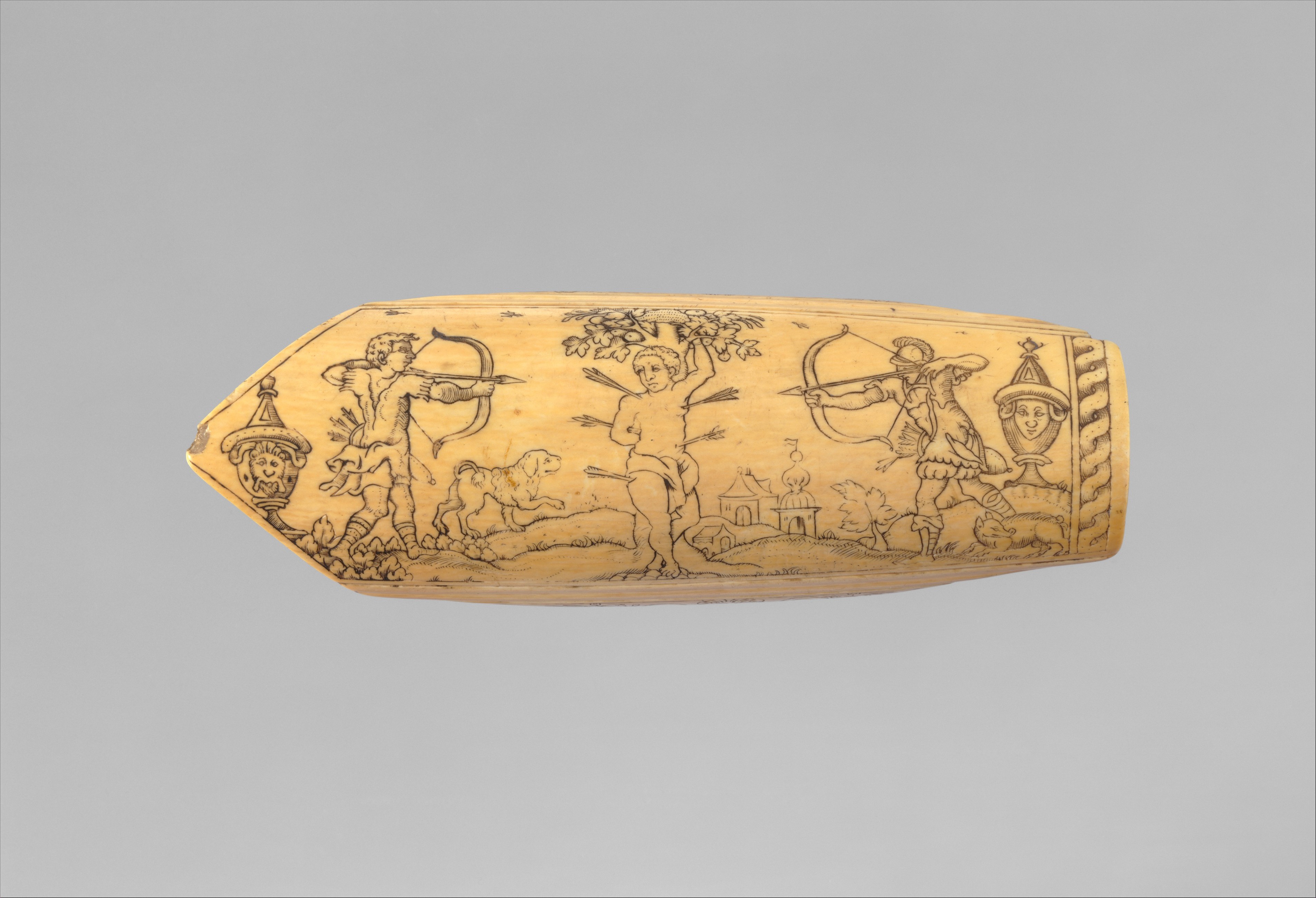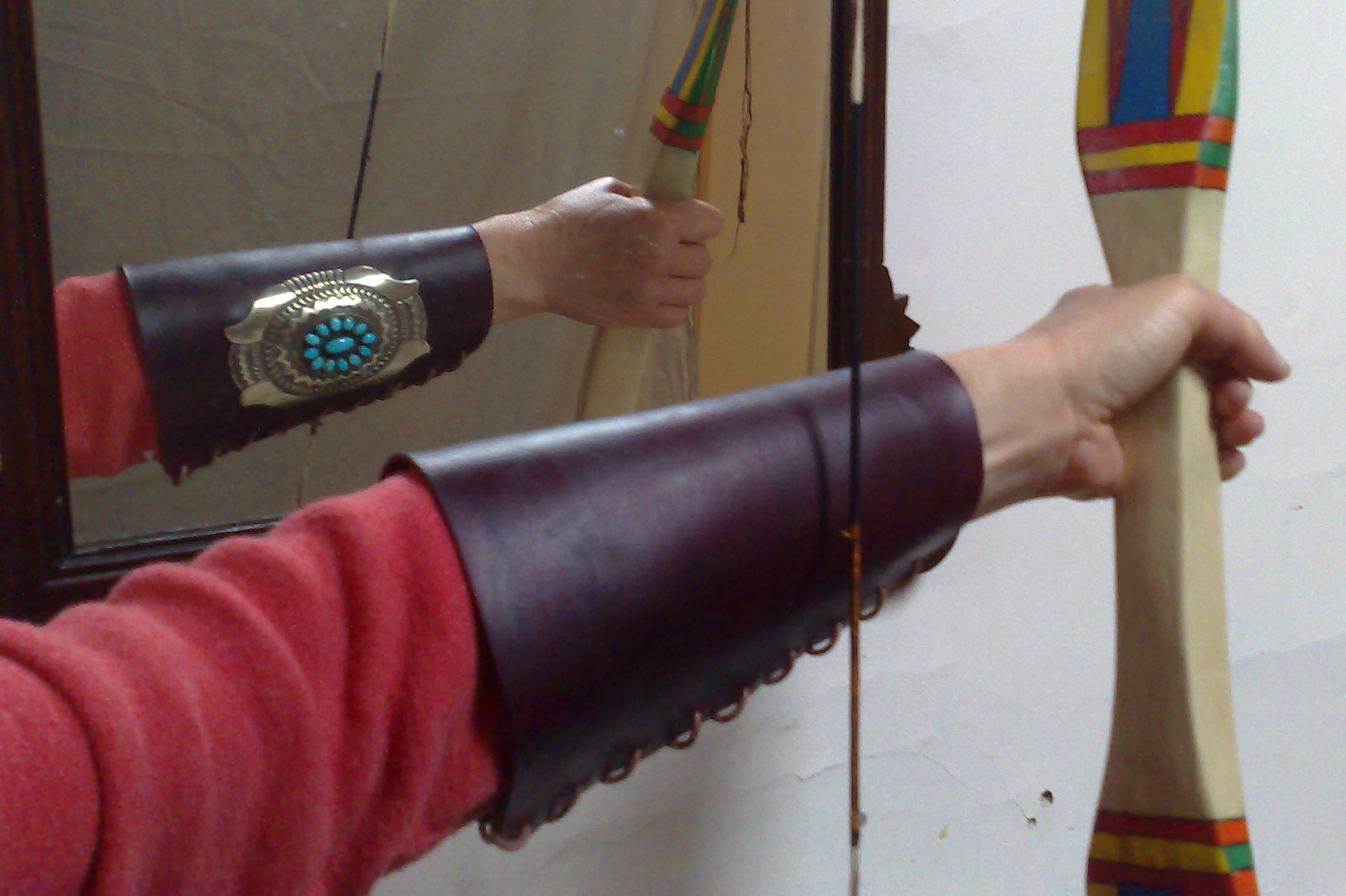Bracer on:
[Wikipedia]
[Google]
[Amazon]
 A bracer (or arm-guard) is a strap or sheath, commonly made of
A bracer (or arm-guard) is a strap or sheath, commonly made of
''Proceedings of the Prehistoric Society 2008,'' vol. 74, pp. 109-149 Ketohs usually have a central motif, sometimes with a stone ornament, and four curvilinear shapes that radiate toward the corners. Ketohs may have a smooth leather surface on the inside of the arm and are then functional, but they are normally used as items of personal and ritual adornment, or as works of art in their own right. Stone wrist-guards from Beaker culture graves of the European Bronze Age have been thought to be archery bracers. However, they are usually found on the outside of the arm where they would have been more conspicuous. Many have only two holes which would make them difficult to fasten securely to the arm, and some have projecting rivets which would catch on the bow string and make them unsuitable for use as a bracer. Many show great skill in polishing and stone working, and few are found in areas from which their stone originates. When the objects occur in
Stone wrist-guards from Beaker culture graves of the European Bronze Age have been thought to be archery bracers. However, they are usually found on the outside of the arm where they would have been more conspicuous. Many have only two holes which would make them difficult to fasten securely to the arm, and some have projecting rivets which would catch on the bow string and make them unsuitable for use as a bracer. Many show great skill in polishing and stone working, and few are found in areas from which their stone originates. When the objects occur in Hunter and Woodward et al "An Examination of Prehistoric Stone Bracers from Britain"
An Examination of Prehistoric Stone Bracers from Britain
Archer's Gear: The bracer
La Belle Compagnie Website
Roundway G8 burial
Wiltshire Heritage Museum, Devizes
Ketohs
collection of the National Museum of the American Indian {{Archery Archery Medieval armour Native American jewelry Native American tools
 A bracer (or arm-guard) is a strap or sheath, commonly made of
A bracer (or arm-guard) is a strap or sheath, commonly made of leather
Leather is a strong, flexible and durable material obtained from the tanning, or chemical treatment, of animal skins and hides to prevent decay. The most common leathers come from cattle, sheep, goats, equine animals, buffalo, pigs and ho ...
, stone or plastic
Plastics are a wide range of synthetic or semi-synthetic materials that use polymers as a main ingredient. Their plasticity makes it possible for plastics to be moulded, extruded or pressed into solid objects of various shapes. This adaptab ...
, that covers the ventral (inside) surface of an archer's bow-holding arm. It protects the archer's forearm
The forearm is the region of the upper limb between the elbow and the wrist. The term forearm is used in anatomy to distinguish it from the arm, a word which is most often used to describe the entire appendage of the upper limb, but which in ...
against injury by accidental whipping from the bowstring or the fletching of the arrow
An arrow is a fin-stabilized projectile launched by a bow. A typical arrow usually consists of a long, stiff, straight shaft with a weighty (and usually sharp and pointed) arrowhead attached to the front end, multiple fin-like stabilizers ...
while shooting, and also prevents the loose sleeve from catching the bowstring. They normally only cover part of the forearm, but full-length bracers extending to the upper arm are also available, and other areas have been covered by some archers. In addition, chest guards are sometimes worn, usually by female archers, to protect the breast
The breast is one of two prominences located on the upper ventral region of a primate's torso. Both females and males develop breasts from the same embryological tissues.
In females, it serves as the mammary gland, which produces and s ...
. With some combinations of non-baggy clothing and bows with a larger distance between the bow and the string, the archer may not need to wear any bracer.
Decorated bracers
The modernNavajo people
The Navajo (; British English: Navaho; nv, Diné or ') are a Native American people of the Southwestern United States.
With more than 399,494 enrolled tribal members , the Navajo Nation is the largest federally recognized tribe in the United ...
and Hopi
The Hopi are a Native American ethnic group who primarily live on the Hopi Reservation in northeastern Arizona, United States. As of the 2010 census, there are 19,338 Hopi in the country. The Hopi Tribe is a sovereign nation within the Unite ...
developed a form of bracer known as a ketoh, which can be decorated with silver, turquoise, and other adornments, possibly from earlier examples made of bone.Harry Fokkens, Yvonne Achterkanp, and Maikel Kuijpers, "Bracers or Bracelets? About the Functionality and Meaning of Bell Beaker Wrist-guards"''Proceedings of the Prehistoric Society 2008,'' vol. 74, pp. 109-149 Ketohs usually have a central motif, sometimes with a stone ornament, and four curvilinear shapes that radiate toward the corners. Ketohs may have a smooth leather surface on the inside of the arm and are then functional, but they are normally used as items of personal and ritual adornment, or as works of art in their own right.
 Stone wrist-guards from Beaker culture graves of the European Bronze Age have been thought to be archery bracers. However, they are usually found on the outside of the arm where they would have been more conspicuous. Many have only two holes which would make them difficult to fasten securely to the arm, and some have projecting rivets which would catch on the bow string and make them unsuitable for use as a bracer. Many show great skill in polishing and stone working, and few are found in areas from which their stone originates. When the objects occur in
Stone wrist-guards from Beaker culture graves of the European Bronze Age have been thought to be archery bracers. However, they are usually found on the outside of the arm where they would have been more conspicuous. Many have only two holes which would make them difficult to fasten securely to the arm, and some have projecting rivets which would catch on the bow string and make them unsuitable for use as a bracer. Many show great skill in polishing and stone working, and few are found in areas from which their stone originates. When the objects occur in barrow
Barrow may refer to:
Places
England
* Barrow-in-Furness, Cumbria
** Borough of Barrow-in-Furness, local authority encompassing the wider area
** Barrow and Furness (UK Parliament constituency)
* Barrow, Cheshire
* Barrow, Gloucestershire
* Barro ...
s, they always occur in the central primary grave, a place thought to be reserved for heads of family and other important people. They may have been status symbols of prowess in hunting or war, probably mounted as decorations on functional bracers. A few wrist-guards made of gold or amber have also been found; scholars believe these were for ornamental rather than functional use. A review identifies two major sources of stone from which they are made, suggests that they may well not be connected with archery, and highlights other potential uses.An Examination of Prehistoric Stone Bracers from Britain
Other uses
Bracers have also been used in other sports, includingball games
This is a list of ball games and ball sports that include a ball as a key element in the activity, usually for scoring points.
Ball games
Ball sports fall within many sport categories, some sports within multiple categories, including:
* Bat-a ...
such as Follis
The follis (plural ''folles''; it, follaro, ar, فلس, Fels) was a type of coin in the Roman and Byzantine traditions.
Roman coin
In the past, the term ''follis'' was used to describe a large bronze Roman coin introduced in about 294 (the ...
(played in ancient Rome
In modern historiography, ancient Rome refers to Roman civilisation from the founding of the city of Rome in the 8th century BC to the collapse of the Western Roman Empire in the 5th century AD. It encompasses the Roman Kingdom (753–50 ...
).
In many common role-playing games
A role-playing game (sometimes spelled roleplaying game, RPG) is a game in which players assume the roles of player character, characters in a fictional Setting (narrative), setting. Players take responsibility for acting out these roles within ...
, bracers are a general piece of armour rather than protective archery equipment, possibly due to confusion with vambraces
Vambraces (French: ''avant-bras'', sometimes known as ''lower cannons'' in the Middle Ages) or forearm guards are ''tubular'' or ''gutter'' defences for the forearm worn as part of a suit of plate armour that were often connected to gauntlets. V ...
.
Notes
External links
Archer's Gear: The bracer
La Belle Compagnie Website
Roundway G8 burial
Wiltshire Heritage Museum, Devizes
Ketohs
collection of the National Museum of the American Indian {{Archery Archery Medieval armour Native American jewelry Native American tools